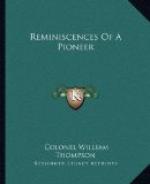This was especially conspicuous in the Pine Ridge outbreak. The medicine men made their deluded followers believe the white men were all to be killed, that the cattle were to be turned to buffalo and that the red man would again possess the country as their fathers had possessed it in the long ago, and that all the dead and buried warriors were to return to life. This doctrine was preached from the borders of Colorado and the Dakotas to the Pacific, and from British Columbia to the grottoes of the Gila. The doctrine probably had its origin in the ignorant preaching of the religion of the Savior by honest but ignorant Indian converts. They told their hearers of the death, burial and resurrection of the Son of Man. The medicine men seized upon the idea and preached a new religion and a new future for the red man. Missionaries were sent from tribe to tribe to preach and teach the new doctrine, and everywhere found willing converts.
The craze started in Nevada, among the Shoshones, and in a remarkably short time spread throughout the tribes on both sides of the Rocky Mountains. Lieutenant Strothers of the United States Army and I talked with Piute Indians in Modoc County, after the “ghost dance” scare had subsided, who were firm in the belief that a chief of the Piutes died and then came back. They assured us that they had talked with a man who had seen him, and that there could be no mistake. But they said: “Maybe so; he did not know. The white man medicine heap too strong for Ingin.”
So it was with the Bannocks. Their medicine men taught that the white man was to be destroyed, that his horses, his cattle and his houses and land were to revert to the original owners of the country. Accordingly few houses were burned throughout the raid of several hundred miles. Even the fences around the fields were not destroyed, but were left to serve their purposes when the hated white man should be no more. The few exceptions were where white men were caught in their homes and it was necessary to burn the buildings in order to kill the owners. The home of old man Smith in Happy Valley, on the north side of Stein Mountain, the French ranch in Harney and the Cummins ranch on the John Day were exceptions. In the fights at these places some of the Indians were killed and the houses were burned out of revenge. With characteristic Indian wantonness and wastefulness hundreds of cattle were shot down, only the tongue being taken out for food. They, however, would come back as buffalo and cover the land with plenty. But horses were everywhere taken, and when that armed, mounted and tufted host debouched into Harney Valley they had a mighty herd of from seven to ten thousand horses.
The Bannocks, under their noted chief, Buffalo Horn, left their reservation in Idaho and at once began the work of murder and plunder. Buffalo Horn had served under Howard during a portion of the Nez Perce war, but left him because of his dilatory tactics and his refusal to attack when he had the enemy at his mercy. He told Col. Reddington, who was following Howard as correspondent of the Oregonian and New York Herald, that Howard did not know how to fight, that next summer he would fight and show him how to make war.




